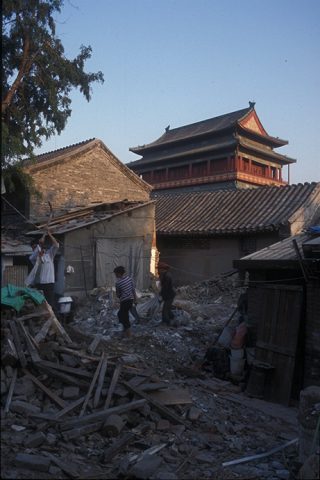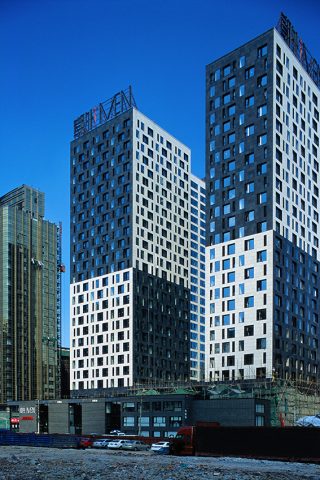Reportage #2 (interview #13)
Tales from China
Claudio Greco
testo di Sebastian Di Guardo

Demolitions in Gulou, courtesy of Claudio Greco.
Perchè si trovava in Cina?
È accaduto un pò a causa della mia curiosità di viaggiatore, un pò per motivi casuali. Era il 1989, anno degli eventi di piazza Tienanmen, e in quel tempo era ospite a Tor Vergata un ingegnere cinese che era uno dei pochi all’epoca a parlare inglese. Era un giovane ingegnere che aveva fatto da guida ad alcuni professori dell’Università in visita a Pechino e quindi fu invitato ad esporre la situazione dell’ingegneria cinese degli anni ‘80 presso la nostra facoltà. Ricordo che ci presentò un quadro che dipingeva una realtà ancora modesta e arretrata. Iniziò quindi per me un periodo prima di amicizia e quindi di collaborazione, che culminò con un suo invito in Cina nel 1994, quando il suo paese aveva appena compiuto un cambiamento verso un’economia di tipo occidentale. Lui era uno dei giovani chiamati a guidare, in un nuovo studio di progettazione, questo cambiamento. Cominciarono infatti degli scambi culturali sempre più frequenti, promossi dal governo cinese; al contrario del nostro paese (ride) Canada, Francia e Germania ne approfittarono offrendo borse di studio ai giovani cinesi. Superati gli studi, questi ragazzi divennero la base per la nuova classe di progettisti cinesi. Questi giovani progettisti in occasione di eventi come l’Expo e le Olimpiadi a loro volta chiamarono a collaborare molti architetti e ingegneri conosciuti in Occidente. Penso all’opera di Pechino di Paul Andreu, fino ai molti complessi residenziali progettati da professionisti tedeschi.
Col senno di poi trova più proficuo di quel periodo il lavoro in studio o invece alcuni temi di ricerca che ha poi portato avanti? Penso per esempio al tema del restauro al quale ha anche dedicato delle pubblicazioni.
Sono stati sicuramente molto utili le riflessioni sulla manipolazione dei riferimenti architettonici. La crescita dell’architettura moderna cinese ha avuto come incipit quell’architettura – o meglio quel collage di architetture – che i giovani progettisti cinesi vedevano nelle riviste patinate occidentali. I risultati che ne venivano sintetizzati potevano essere ridicoli, banali o ingenui, ma questa palestra ha consentito una successiva piena maturazione di un’architettura cinese moderna. Una seconda riflessione importante è stata sul tema della salvaguardia del patrimonio edilizio storico cinese. I presupposti storici e culturali nel nostro paese e in Cina sono diversi, così come l’atteggiamento dei cinesi verso l’antico, e questo confronto ha permesso una maturazione delle mie idee.
CLAUDIO GRECO TALES FROM CHINA
text by Sebastian Di Guardo; translations by Laura Dumbrava

Group – Strategy Architecture, Chaowaymen, 2004, courtesy of Mc Millan for the Cludio Greco Book Pechino, la città nuova (Skyra 2008).
Why did you go to China?
One reason was because of my own curiosity as a traveller, another one would be for a causal reason. It was back in 1989, year of events in Tiananmen market, and at that period of time I was the guest of a Chinese engineer who was one of the fewest capable of speaking English. He was a young engineer who guided some of the University’s professors while visiting Pechino and therefore, he was invited to expose the 80’s Chinese engineering situation at our faculty. I remember that he presented us a painting of a modest and backward reality. Everything began with a period of friendship, therefore collaboration, which reached its peak with him inviting me in China, in 1994, when his country suffered a shift of its economy to an Occidental one. He was one of the youngsters implied in this process, in a new design studio. It often occurred, indeed, cultural changes promoted by the Chinese government. As opposed to our country (laughs) Canada, France and Germany took advantage by giving scholarships to the Chinese youth. As soon as these young people finished their studies, they would have become the base of the new class of Chinese designers. These designers during events, such as Expo or the Olympics, invited to collaboration many architects and well known engineers in Occident.
I’m thinking of Pechino’s work of art done by Paul Andreu and of many other residential projects done by German professionals.
Recalling those memories, do you think that period of work in a studio or any other research topics were more advantageous than those of nowadays? For instance, the restoration topic on which you also wrote.
The manipulation of architectural references was, certainly, very useful. The Chinese modern architecture’s growing had as a beginning that type of architecture – or better, that type of architecture collage – which young Chinese designers saw in the Occidental magazines. The results could have been considered ridiculous or pathetic, but this step allowed a further maturation of the Chinese modern architecture. A second important thought was the topic of the safeguard of the Chinese historical heritage building. The so-called cultural historians in our country and China are different, like the Chinese’ attitude towards the ancient, and this thought allowed a maturation of my ideas.
